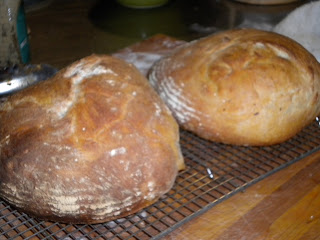So we’re coming down the home stretch to Christmas dinner. We made the plum pudding the weekend after Thanksgiving and the brown beef stock for the gravy, which was frozen in 2 qt. plastic bags. The standing rib roast is waiting in the fridge, and on Christmas day will be going into a hot oven in the late morning. We’re going to have Yorkshire pudding, herb-roasted potatoes, baby buttered peas, glazed carrots, and a mixture of roasted cauliflower flowerets and Brussels sprouts.
Many people find Brussels sprouts undesirable as a vegetable. They are often eschewed as “those little cabbages,” and when overcooked they do emit sulfur compounds that are bitter and odiferous, making them unappetizing. However, if properly handled, they are crisp and tasty, with a mild bitterness that is not displeasing. Those that have been touched by fall’s frosts are the sweeter for the nipping.
One way to make them less bitter is to cut them in half, exposing their inner leaves, which will allow the bad flavor elements to leach out. Another is to give them a preliminary blanching in boiling water for a minute before draining and proceeding with your recipe.
Brussels sprouts provide a hearty winter vegetable to accompany turkey, steaks or liver, but they really love pork, duck or goose. They pair well with cauliflower, Jerusalem artichokes, leeks and chestnuts, whether as a vegetable combination or in a wholesome fall vegetable pie.
Brussels sprouts, a member of the Brassica oleracea family, are derived from the wild cabbage and, therefore, other family members include collards, kohlrabi and kale. Something akin to the modern Brussels sprout was cultivated in Italy, but Belgium has recorded evidence of its growing there in 1587, as the vegetable proliferated in northern Europe due to the cool climate in which it thrives.
Rich in vitamin C, Brussels sprouts also have large amounts of vitamin A, folic acid and dietary fiber. Some of their unappetizing compounds are actually thought to be helpful in preventing colon cancer
Through the fall months, one can purchase local Brussels sprouts on long stems at farmers’ markets. The little green heads grow up and down the stalk, becoming 1” to 2” in diameter at maturity. The heads should be tight with bright green leaves. Any that are over mature, wilted or worm-eaten should be discarded. Sometimes one or two leaves at the base may have to be removed. It’s advisable to trim the base of each sprout and, using a paring knife, cut a small X to facilitate even cooking.
After prepping the sprouts, they should be washed and parboiled in salted water for 5 to 6 minutes or until almost tender. They can be refreshed in cold water and saved for final cooking later. Whether braised in butter, cooked in cream or cheese sauce, or braised with chestnuts, cook slowly to allow the sprouts to absorb the sauce, but don’t overcook.
Brussels sprouts also lend themselves to roasting in a hot oven. Toss in olive oil, salt and pepper and scatter on a parchment lined sheet pan before cooking at 425 degrees for 25 minutes, tossing once or twice.





































